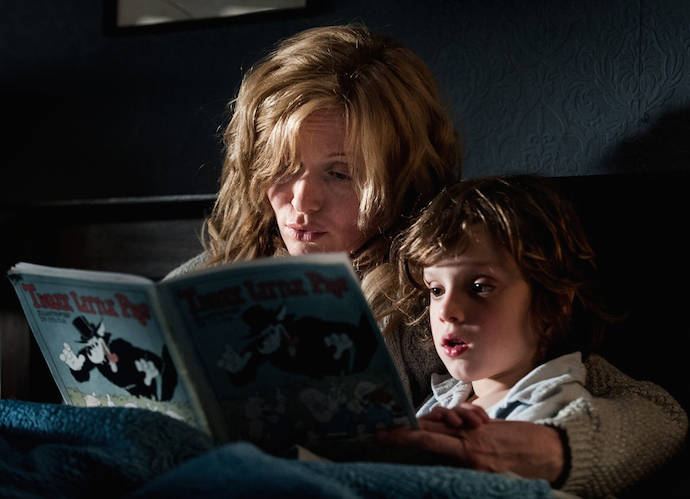The Babadook Review: Not Your Ordinary Horror Film

4/5
The Babadook is a reality driven horror film. I mean this despite the fact there’s a supernatural parasite in it. So rarely are the characters in a horror movie actually more than just meat to feed a grinder. Here, these are actual people with actual problems dealing with a crisis beyond their understanding.
There is a mix of several horror film mainstays blended into something that isn’t entirely new, but still very much engaging. This is an Australian production that was funded via Kickstarter and cost on $30,000 make. In most cases, this would make the entire movie look and feel cheap, but director Jennifer Kent (who also wrote the film) uses the shoestring budget to full effect. There are long shots and few locations. The house they’re filming in is dilapidated and is every bit a character in the story as anyone else. While most of the money went toward the art department to make certain the horrific bits were off-putting and well realized, Kent knew that in order to overcome the lack of funds, her movie would have to have strong actors working off a strong script. She delivered.
We follow a widow Amelia (Essie Davis) and her damaged son Samuel (Noah Wiseman) through their everyday lives: Amelia is overworked and still unable to cope with the loss of her husband who died in a car accident the day Samuel was born. Samuel himself has clear abandonment issues and behavioral problems. He’s constantly fearful and often lashes out. He suffers night terrors. He may have be suffering from hallucinations.
Amelia’s life is dreary and full of difficulty. Her sister Prue (Cathy Adamek) is tired of her sister’s depression and of Samuel’s odd behavior. Prue and her daughter make it clear that they hate Samuel, who admittedly doesn’t make himself easy to like. One night, Samuel notices a children’s pop-up book on his shelf he’s never seen before. His mother reads it to him, and reveals the story of the evil Babadook (Tim Purcell) who will invade your home, have you kill your child and make you kill yourself. Once he’s summoned by reading the book he can’t go away (similar to Pinhead and the puzzle box). His face is disfigured, and he’s dressed in fairly normal clothes, and has very sharp claws (similar to Freddy Krueger). Over time he drives those he targets insane and feeds on their misery, often using hallucinations and very specific pieces of that person’s history to destroy them.
Using this tact, Kent forces the story into a more character-centric arc. In order to overcome the Babadook, Amelia has to confront the trauma of her past, her own PTSD, and the fear and nearly genuine dislike she has for her own son. The narrative sometimes switches between a possessed Amelia unloading her true feelings about Samuel to his face, and Samuel coming to grips with how the world views him. He turns his fear and paranoia into something more useful—a way to fight the Babadook. Some of Samuel’s ideas seem straight out of Home Alone but still feel childlike (if not a bit more pathologically violent), and paranoia can be quite helpful when someone is actually after you.
https://www.youtube.com/watch?v=szaLnKNWC-U
Samuel’s fears and his own damaged personality are clearly explored, most sadly in the tree house scene when his cousin breaks down that no one likes him and why. It’s the brutal clarity children have that Kent has distilled and it’s a tough and sad little scene. Samuel breaks his cousin’s nose, and for a moment we cheer for him, and then realize that his cousin was right all along. Babadook initially targets Samuel, causing him to hallucinate and seize, but changes his mind and targets Amelia. It’s never overtly stated but the reason is fairly clear. For all of Samuel’s trauma and fear, Amelia’s runs so much deeper. He repeatedly appears in the guise of Oskar (Benjamin Winspear), Amelia’s dead husband who will remind her of his violent death and attempt to persuade Amelia into the murder-suicide.
Despite the Babadook having the film’s title, this is Amelia’s show. Essie Davis with her frizzy unkempt hair and pale skin lined in a road-map of worry and stress brings Amelia to life. She’s genuine in her reactions to things—particularly the kitchen scene at the party—and gives this horror film its grounded nature. This isn’t an evil creature attacking sexy teenagers. This is an evil creature rending the already meager sanity of an already downtrodden unfortunate woman.
Like in most horror films that involve a haunting or some supernatural entity, the question becomes, “If you’re this powerful, why do you wait so long to go in for the kill?” Babadook seems to have the same flaw; as parasitic as he is on human emotion, he also apparently can be nourished by earthworms. It’s a confusing piece of material and is just in another of a long line of horror villains who would be successful if not for the fact that the movie needs to go on for 90 minutes. However, Jennifer Kent has established that this isn’t really about the Babadook, it’s about overcoming the past that the Babadook does so love to remind his victims of. Therefore the horror is more psychological and methodical. There’s hardly any blood and there are no real jump scares. The horror comes from the music, the palpable dread, and though we do occasionally see the Babadook the real terror we feel comes from the possession of Amelia who tries to kill Samuel.
Amelia, at times, is clearly trying to fight off the alien influence but near the end succumbs and we follow a good ten minute period where it’s Amelia/Babadook versus Samuel that is really quite scary and doesn’t need gloved dream monsters or S&M demons to drive the fear home to the audience.
It’s about confrontation, and when Samuel is able to fight off the Babadook briefly and save his mother we feel excited and relieved, and then more worried. It’s up to Amelia now and she can’t get her life together enough to work five days a week. The story switches back to her, so she can have her moment—a real make or break one where the situation isn’t so much about Amelia facing the Babadook but about Amelia facing the death of her husband.
When a shaken Amelia manages to confront the monster without fear, dress down the Babadook like he was a misbehaving dinner guest, we can’t help but cheer. We feel the catharsis she does. Amelia stops shaking. Her eyes point to focus. The Babadook who we’ve established cannot leave once he arrives realizes that he hasn’t imprisoned Amelia but now she has imprisoned him. The Babadook still resides in the house, but is now relegated to the darkest corner of the basement where Amelia keeps and intermittently feeds him.
Then, it’s hard not to see the Babadook as a non-literal personification of trauma. PTSD is some you can beat but never defeat. We can overcome some of its tricks and trades. We can recognize the damage it has done to us and how it makes us lash out. Sometimes we can beat it but it will always be there. It will attack in ways large or small. It may change in time but its DNA will always have the same pattern. We have to take it one day at a time.
The ending isn’t sappy nor is it vague. It’s clear that Amelia has a long, hard road to travel (CPS is investigating her) and Kent made the decision not to just to fast forward to a point where Amelia has gotten her hair done and is happily dating another man or find Samuel is the prince of his new school, we’re given something so sadly real. Little progress, small beats. “We’re taking it a day at a time,” Amelia says, rallying.
RELATED ARTICLES
Get the most-revealing celebrity conversations with the uInterview podcast!







Leave a comment